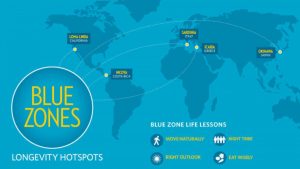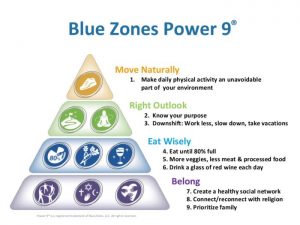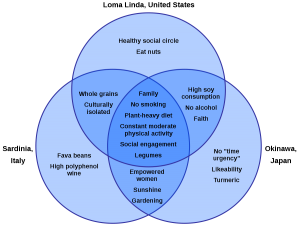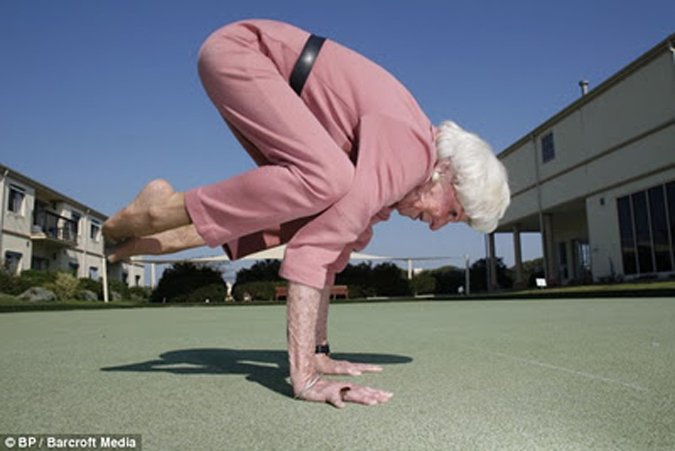People in the world’s Blue Zones

Identifying and studying the longest-lived people, those who are in what we called the world’s Blue Zones. These are people who have eluded heart disease, diabetes, dementia, and several types of cancer.
Since only about 20% of the average person’s life span is dictated by genes, I reasoned that if I could find the common denominators among people who’ve achieved the health outcomes we want, I might distill some pretty good lessons for the rest of us to follow. I discovered nine powerful lessons—the power nine—that underpin all five Blue Zones. Here they are:
1. Eat mostly plants.
Beans, including fava, black, soy, and lentils, are the cornerstone of most centenarian diets. Meat—mostly pork—is eaten on average only five times per month. Serving sizes are 3 to 4 ounces, about the size of a deck of cards.
2. Follow the 80% rule.
Hara hachi bu, the Okinawan, 2,500-year-old Confucian mantra said before meals, reminds them to stop eating when their stomachs are 80% full. The 20% gap between not being hungry and feeling full could be the difference between losing weight and gaining it. People in the Blue Zones eat their smallest meal in the late afternoon or early evening, and then they don’t eat any more for the rest of the day.
3. Move naturally.
The world’s longest-lived people don’t pump iron, run marathons, or join gyms. Instead, they live in environments that constantly nudge them into moving without thinking about it. They grow gardens and don’t have mechanical conveniences for house and yard work.
4. Find purpose.
The Okinawans call it ikigai and the Nicoyans call it plan de vida; for both it translates to “why I wake up in the morning.” Knowing your sense of purpose is worth up to seven years of extra life expectancy.

5. Downshift.
Even people in the Blue Zones experience stress. Stress leads to chronic inflammation, associated with every major age-related disease. What the world’s longest-lived people have that we don’t are routines to shed that stress. Okinawans take a few moments each day to remember their ancestors, Adventists pray, Ikarians take a nap, and Sardinians do happy hour.
6. Drink wine at 5.
People in all Blue Zones (except Adventists) drink alcohol moderately and regularly. Moderate drinkers outlive non-drinkers. The trick is to drink one to two glasses per day (preferably Sardinian Cannonau wine) with friends and/or with food. And no, you can’t save up all week and have 14 drinks on Saturday.
7. Put loved ones first.
Successful centenarians in the Blue Zones put their families first. This means keeping aging parents and grandparents nearby or in the home. (It lowers disease and mortality rates of children in the home too.) They commit to a life partner (which can add up to three years of life expectancy) and invest in their children with time and love (and they’ll be more likely to care for you when the time comes).
8. Find belonging.
All but five of the 263 centenarians we interviewed belonged to some faith-based community. Denomination doesn’t seem to matter. Research shows that attending faith-based services four times per month will add four to 14 years of life expectancy.
9. Find the right community.
The world’s longest-lived people chose—or were born into—social circles that support healthy behaviors. For example, Okinawans created moais—groups of five friends that committed to each other for life. Research from the Framingham Studies shows that smoking, obesity, happiness, and even loneliness are contagious. So the social networks of long-lived people have favorably shaped their health behaviors.

To make it to age 100, you have to have won the genetic lottery. But most of us have the capacity to make it well into our early 90s and largely without chronic disease. As the Adventists demonstrate, the average person’s life expectancy could increase by 10 to 12 years by adopting a Blue Zones lifestyle.











